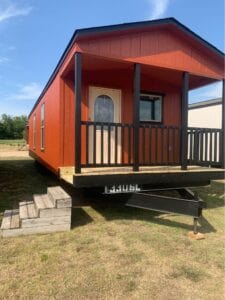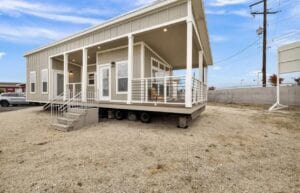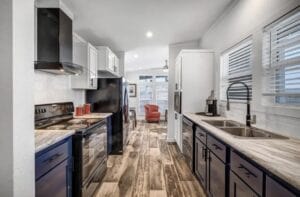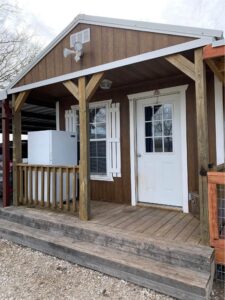Tiny homes have become a popular alternative to traditional homes for people looking to downsize and simplify their lives. These small houses are typically less than 400 square feet and designed to maximize space while minimizing clutter. Tiny house builders offer a variety of options, including custom designs and pre-built shells that can be finished by the homeowner. In this article Tiny Home For Sale Texas we will discuss all the options to buying, setting and financing your tiny home.
Tiny Home For Sale Texas
If you’re interested in tiny home living, you might be wondering why someone would choose such a small space over a traditional home. One reason is affordability. Tiny homes can be more affordable than traditional homes, making it easier for people to become homeowners. Living in a tiny home can reduce environmental impact and allow individuals to live a more minimalist lifestyle.
So how are tiny homes built? There are many different methods and materials used in the construction of these small houses. Some builders use traditional stick framing techniques, while others opt for steel frames or even repurposed shipping containers. The key is to maximize every inch of space while still creating a functional and livable environment.
Tiny homes have been growing in popularity over the past decade, with more people showing interest in this unique way of living. While there’s no one definitive answer as to when tiny homes became popular, it’s safe to say that the trend has gained momentum in recent years thanks to social media platforms like Instagram and Pinterest.
But are tiny homes worth buying? That depends on your individual needs and preferences. If you’re looking for an affordable way to become a homeowner or want to reduce your environmental impact, then a tiny home might be right for you. However, if you need more space or prefer a more traditional style of living, then a tiny home may not be the best fit.
There are many different companies and individuals offering their services. Some specialize solely in building custom-designed tiny houses, while others offer pre-built shells that can be finished by the homeowner themselves.

Understanding the Cost of Tiny Homes: Factors that Affect the Price
Factors That Affect the Price of Tiny Homes
Cost is a significant factor for anyone considering purchasing or building a tiny home. While tiny homes are generally more affordable than traditional homes, there are still several factors that affect their price. In this section, we’ll discuss some of the most important factors that influence the cost of tiny homes.
Size Matters
The size of a tiny home has a significant impact on its cost. Generally speaking, the larger the home, the more expensive it will be. However, it’s not just about square footage; other factors like ceiling height and room layout can also affect the overall cost.
For example, a 200-square-foot home with high ceilings may be more expensive than a 300-square-foot home with lower ceilings because it requires more materials to build taller walls. Similarly, a complex room layout with multiple levels or unusual angles may require additional construction time and materials, driving up costs.
Materials Used
Another critical factor in determining the cost of a tiny home is the type and quality of materials used in its construction. High-end finishes like granite countertops and hardwood flooring will increase costs significantly compared to more affordable options like laminate countertops and vinyl plank flooring.
Eco-friendly features like solar panels or composting toilets can add thousands of dollars to the price tag but may be worth it for those seeking sustainability or off-grid living.
Location
Where you build or purchase your tiny home can also have an impact on its final cost. Labor and material costs vary by region; therefore, building your house in an area with higher wages or pricier building supplies will drive up expenses.
Similarly, buying land in desirable locations such as urban centers or coastal areas can also increase costs significantly. It’s essential to research local prices before making any decisions about where to build or buy your tiny home.
DIY vs Professional Building
While DIY building can save money on labor costs since you’re doing all (or most) of the work yourself, it requires significant time and skill to complete a project. Most people who choose this route have some construction experience or are willing to learn as they go.
On the other hand, hiring professionals can ensure that your home is built correctly and efficiently, but it comes at a higher price. It’s essential to weigh the pros and cons of each option carefully before deciding which one is right for you.
Financing Options
Financing options for tiny homes are limited compared to traditional mortgages. Many lenders consider tiny homes as recreational vehicles or mobile homes, making them ineligible for standard mortgage financing.
As a result, those looking to purchase a tiny home may need to explore alternative financing options like personal loans or RV loans. However, these types of loans often come with higher interest rates than traditional mortgages.
Maintenance Costs
Finally, while maintenance costs for tiny homes are generally lower than traditional homes due to their smaller size, unexpected repairs can still add up over time. It’s important to budget accordingly and plan for routine maintenance like roof inspections and appliance upkeep.
Financial Considerations when Buying a Tiny House: Tips for Budgeting and Financing Your Dream Home
Budgeting is Crucial When Buying a Tiny House
If you’re considering buying a tiny house, budgeting should be one of your top priorities. While they may seem like an affordable housing option, tiny homes require significant upfront investments and ongoing expenses such as utilities and maintenance. Before purchasing a tiny home, it’s essential to create a budget that takes into account all of the costs associated with owning one.

When creating your budget, consider the cost of the tiny home itself, as well as any additional expenses such as land or parking fees, utilities, insurance, and maintenance costs. It’s also important to factor in any potential increases in living expenses if you plan on downsizing from a larger home.
Financing Options for Tiny Homes in Texas
Once you’ve created a budget for your tiny home purchase, it’s time to explore financing options. There are several ways to finance a tiny home purchase, including personal loans, land loans, and traditional mortgages.
Personal loans are typically unsecured loans that can be used for any purpose. They are often easier to obtain than other types of loans but may come with higher interest rates. Land loans are another popular option for those looking to purchase land to build their tiny home on. However, they typically require a larger down payment and higher interest rates than traditional mortgages.
Traditional mortgages may also be an option for financing your dream tiny home. However, not all lenders offer mortgages for non-traditional homes like tiny houses. It’s essential to shop around for the best loan terms and interest rates when considering this option.
Additional Considerations When Financing Your Tiny Home in Texas
When financing your tiny home purchase, there are several additional factors to consider beyond just loan terms and interest rates. For example:
Insurance: You’ll need insurance coverage for both your tiny home and any property it sits on. If you are looking for great insurance for your tiny house click here. Our customers on average save $250 per year.
Monthly payments: Make sure you can comfortably afford monthly payments before committing to financing.
Credit score: Your credit score will impact your ability to obtain financing and the interest rates you’re offered.
Down payment: Depending on the type of loan, you may need to make a significant down payment upfront.
Finding the Right Location for Your Tiny Home: Land, Zoning and Permitting Considerations in Texas
Research local zoning laws before purchasing land for your tiny home
Before you start planning your dream tiny home, it’s essential to research the zoning laws in your desired location. Zoning laws are regulations that dictate how land can be used within a specific area. Some cities and towns have strict zoning laws while others may not have any at all.
It’s crucial to understand these laws because they can impact where you can park or build your tiny home. Some areas may only allow tiny homes in designated communities, while others may require them to be on permanent foundations. Some areas may require a certain square footage for residences or a minimum lot size.
Consider the size and type of land needed for your specific tiny home model
Once you’ve researched the zoning laws in your desired location, it’s time to consider the size and type of land needed for your specific tiny home model. Different models of tiny homes will require different amounts of space, so make sure you know what you need before purchasing land.
For example, if you plan on building a larger tiny home with multiple bedrooms and bathrooms, you’ll need more space than if you’re building a smaller one-bedroom model. Some models may require access to utilities like water and electricity.
Look into Southland-specific zoning and permitting regulations for tiny homes
If you’re planning on building or parking your tiny home in Southland specifically, it’s important to look into the region’s specific zoning and permitting regulations for tiny homes. Each state has its own set of rules when it comes to building codes and permits.
In Southland states such as California or Texas, there are specific guidelines that must be followed when building a permanent residence or parking a mobile dwelling unit like a Tiny Home RV (THRV). For example, THRVs must meet certain safety standards such as fire resistance ratings.
Be Aware of Any Laws Regarding Utilities on Your Chosen Land
Before purchasing land for your tiny home, it’s important to be aware of any laws regarding utilities such as water and electricity. If the land doesn’t have access to these utilities, you’ll need to find alternative sources or consider a different location.
Some areas may require specific types of septic systems or have restrictions on the use of solar panels or composting toilets. Make sure you research these regulations before making any decisions about where to park or build your tiny home.

Check if there are any restrictions on parking or living in a tiny home in your desired location
Finally, it’s essential to check if there are any restrictions on parking or living in a tiny home in your desired location. Some areas may have limitations on how long you can live in a THRV, while others may not allow them at all.
It’s also important to consider parking options for your tiny home. Some areas may require that THRVs be parked only in designated communities, while others may allow them to be parked on private property with certain requirements like setbacks from neighboring properties.
Consult with a professional to ensure you are following all necessary laws and regulations
Navigating zoning laws and building codes can be overwhelming, especially when it comes to something as unique as a tiny home. That’s why it’s important to consult with professionals who can help guide you through the process.
Consider working with an architect who specializes in designing small spaces or hiring a contractor who has experience building tiny homes. Make sure you work with someone who is familiar with the specific zoning and permitting regulations in your desired location.
Choosing the Right Builder for Your Tiny Home: Factors to Consider When Selecting a Builder
Research the Builder’s Experience and Reputation in Building Tiny Homes
When choosing a builder for your tiny home, it is essential to research their experience and reputation in building tiny homes. You want to ensure that you work with a builder who has ample experience in constructing tiny homes and can deliver quality workmanship. Look for builders who specialize in building tiny homes or have a track record of successfully completing such projects.
One way to assess the builder’s experience is by checking their portfolio and previous projects. This will give you an idea of the quality of work they can deliver and whether they can meet your expectations. Reading reviews from past clients can help gauge the builder’s reputation. Positive reviews indicate that the builder has satisfied clients, while negative ones may be a red flag.
Consider the Builder’s Portfolio and Previous Projects
A good tiny home builder should have an extensive portfolio showcasing their previous projects. The portfolio should include photos or videos of completed builds, floor plans, and other relevant details about each project. Reviewing these projects will give you an insight into what types of designs they specialize in, their level of craftsmanship, as well as any unique features they offer.
It is also advisable to ask for references from past clients whom you can contact to get first-hand feedback on their experience working with the builder. This information will help you make an informed decision about whether to hire them or not.
Look for a Builder Who Can Customize Your Tiny Home
Each person has different preferences even when it comes down to small spaces like tiny homes. Therefore, when selecting a tiny home builder, choose one who offers customization options that suit your specific needs and preferences.
Customization options may include selecting materials used during construction, choosing specific appliances or fixtures within your home design plan, among others. A good builder should be able to listen carefully to your requirements and provide recommendations based on their expertise while still adhering to your budget.
Check if the Builder Offers a Warranty or After-sales Service
A good tiny home builder should offer a warranty or after-sales service for their workmanship. This will give you peace of mind, knowing that in case of any issues with the construction, you can easily reach out to them for assistance. The warranty should cover any defects in materials or workmanship for at least one year from the date of completion.
Tips for New Tiny Home Buyers: What You Need to Know Before Making a Purchase
Determining Your Needs Before Making a Purchase
Before making a purchase, it is essential to determine your needs. Tiny homes come in different sizes, shapes, and designs, so it’s crucial to know what you’re looking for before committing to a sale. Think about your lifestyle and how you plan to use the space. Are you living alone or with a partner? Do you need space for guests or pets? Will you be working from home? These are some of the questions that can help guide your decision.
Researching the Seller and Their Reputation Before Committing to a Sale
When buying a tiny home, it’s crucial to research the seller and their reputation before committing to a sale. Look for reviews from previous customers and ask for references from the seller. You can also check if they have any complaints filed against them with organizations like the Better Business Bureau. Doing your due diligence can save you from potential headaches down the line.
Are you interested in selling your tiny home or park model. Visit our article Sell My Mobile Home.
Considering Location and Zoning Laws for Tiny Homes in Your Area
Another important factor to consider when buying a tiny home is location and zoning laws in your area. Some cities have regulations regarding where tiny homes can be parked or built, so make sure to do your research beforehand. Consider factors like climate, access to amenities like grocery stores and hospitals, and proximity to family and friends.
Looking for Energy-Efficient Features To Save on Utility Costs
One of the significant benefits of living in a tiny home is lower utility costs. However, not all tiny homes are created equal efficient heating systems, and insulation that will help keep your energy bills low.
Don’t Forget About Storage Solutions For Your Belongings
Living in a small space requires creativity look for built-in storage options like cabinets under stairs or multi-functional furniture that doubles as storage space. Consider decluttering and downsizing your belongings to make the most of your limited space.
Taking Into Account Any Additional Costs Such as Land Rental or Maintenance Fees
Finally, it’s essential to take into account any additional costs associated with owning a tiny home. If you don’t own land, you’ll need to rent a space to park your tiny home, which can add up over time. Maintenance fees like septic tank pumping or propane refills can add up quickly. Make sure to factor in these costs when creating a budget for your tiny home purchase.
Maximizing Storage in Your Tiny Home: Creative Ideas for Storing Your Belongings in Limited Space
Utilize vertical space
To maximize storage space, it is crucial to utilize every inch of vertical space available. Installing shelves or hanging organizers on the walls can help store items off the floor and free up more space. This is especially useful for small items such as books, kitchen utensils, and toiletries. You can also use over-the-door organizers to store shoes, cleaning supplies, or even jewelry.
Stick to a minimalist lifestyle
Living in a tiny home means living with limited space. Therefore, it is essential to stick to a minimalist lifestyle and only keep essential items that you need. Decluttering your belongings regularly can help reduce clutter and make it easier to maximize your storage space. If you have sentimental items that you cannot part with but do not use frequently, consider storing them elsewhere such as at a family member’s house or renting a storage unit.
Use multi-functional furniture
Multi-functional furniture is an excellent way to maximize storage space in your tiny home without sacrificing style or comfort. A bed with built-in drawers can provide extra storage for clothing and linens while saving valuable floor space. A table that can be folded away when not in use can create more room for activities such as yoga or dance workouts.
Order your belongings by category
Organizing your belongings by category makes it easier to find what you need quickly while maximizing storage space efficiently. For example, keep all kitchen utensils together in one area and designate specific cabinets or drawers for different types of dishes and cookware. Similarly, organize clothes by season and store out-of-season clothes under the bed or in vacuum-sealed bags.
Get creative with storage solutions
There are many creative ways to maximize storage in your tiny home without sacrificing style or functionality. Use a pegboard to hang kitchen utensils or pots and pans on the wall instead of taking up valuable cabinet space. Repurpose old suitcases as storage containers for clothes, books, or other small items. You can also use tension rods under the sink to hang cleaning supplies or attach a magnetic strip to the wall to store knives.

Designing Your Tiny Home: Tips for Creating a Functional and Comfortable Living Space
Must-Have Steps to Consider When Designing the Interior of Your Tiny Home
Designing a tiny home can be a challenging but rewarding experience. One of the most important steps in designing your tiny home is creating a functional and comfortable living space. Here are some must-have steps to consider when designing the interior of your tiny home:
Start with a plan: Before you begin designing, create a detailed list of what you want in your tiny home, including the type of furniture, appliances, and storage solutions you need.
Evaluate your needs: Consider how you will use each area of your tiny home and design accordingly. For example, if you love cooking, make sure you have enough counter space and storage for all your kitchen tools.
Maximize storage: Storage is crucial in a tiny home, so make sure to utilize every inch of space available. Consider built-in shelves, cabinets, and hidden storage spaces to keep clutter at bay.
Choose multi-functional furniture: Opt for furniture that serves multiple purposes such as a sofa bed or table with built-in storage.
Keep it simple: Avoid overcomplicating the design by keeping things simple and streamlined. A minimalist approach can help maximize space and reduce clutter.
Are you interested in selling your tiny home or park model. Visit our article Sell My Mobile Home.
DIY vs Hiring a Designer: Weighing the Risks and Benefits
There are two options – DIY or hiring a designer. Here are some risks and benefits to consider before making your decision:
DIY:
Benefits:
Save money on designer fees
Complete creative control over the design process
Learn new skills
Risks:
Lack of experience may lead to costly mistakes
Limited access to professional resources
Time-consuming process
Hiring a Designer:
Benefits:
Professional expertise in maximizing space and functionality
Access to industry-specific resources
Efficient process with quicker results
Risks:
Higher costs for designer fees
Limited creative control over the design process
Potential miscommunication between client and designer
Types of Construction to Fit Your Custom Plans and Model
When designing a tiny home, it’s important to consider the types of construction available that will fit your custom plans and model. Here are some common types of construction:
Stick-built: This is a traditional method where the walls are built on-site using wood framing.
Modular: A modular home is built in a factory and transported to the site in sections.
Steel frame: Steel frames are durable, lightweight, and can withstand harsh weather conditions.
SIPs (Structural Insulated Panels): SIPs are prefabricated panels made from foam insulation sandwiched between two sheets of plywood or oriented strand board.
Shipping containers: Recycled shipping containers can be repurposed into tiny homes, providing an eco-friendly option.
The Importance of a Functional Layout in Creating a Comfortable Living Space
A functional layout is essential when creating a comfortable living space in your tiny home. Consider these tips when planning your layout:
Open floor plan: An open floor plan creates an illusion of more space and allows for flexibility in furniture placement.
Multi-functional spaces: Designate areas for multiple purposes such as a dining area that can also serve as workspace or storage area.
Traffic flow: Ensure there’s enough room for easy movement between spaces without feeling cramped or cluttered.
Natural light: Incorporate natural light into your design by adding windows or skylights to make your space feel brighter and more spacious.
Time and Experience Required for Successful DIY Tiny Home Construction
Building a tiny home DIY style requires time, effort, patience, and experience to achieve success. Here are some things to keep in mind before embarking on this journey:
Time commitment: Building a tiny home takes time – typically several months to a year or more – depending on the size and complexity of the project.
Required skills: Building a tiny home requires knowledge and experience in construction, electrical work, plumbing, and other trades.
Eco-Friendly Options for Your Tiny Home: Sustainable Materials and Energy-Saving Features to Consider
Alternative building materials such as bamboo, reclaimed wood, and recycled steel can reduce the environmental impact of your tiny home.
Using sustainable materials is not only good for the environment but also for your wallet. Bamboo is an excellent alternative to traditional hardwoods because it grows quickly and doesn’t require much water or pesticides. Reclaimed wood is another eco-friendly option that gives your tiny home character while reducing waste. Recycled steel is durable and long-lasting, making it a great choice for framing.
Using these alternative materials not only reduces your carbon footprint but also saves you money in the long run. Bamboo and reclaimed wood are often less expensive than traditional hardwoods, while recycled steel lasts longer than traditional wood framing.
Options for Energy Saving Features: Tiny Home For Sale Texas
Options for energy-saving features include solar panels, low-flow fixtures, and efficient appliances to reduce your carbon footprint.
One of the biggest advantages of living in a tiny home is that it requires less energy to heat and cool than a larger house. However, there are still ways to make your tiny home even more energy-efficient. Solar panels are an excellent option for powering your tiny home without relying on the grid. Low-flow fixtures like showerheads and faucets reduce water usage without sacrificing performance. Efficient appliances like refrigerators and stoves can save you money on electricity bills over time.
Potential sustainable options for heating and cooling include geothermal systems, radiant floor heating, and mini-split air conditioning units.
Geothermal systems use the earth’s natural temperature to heat or cool your home, making them incredibly energy-efficient. Radiant floor heating uses hot water tubes installed beneath the flooring to provide warmth from below. Mini-split air conditioning units allow you to control each room’s temperature individually without having to cool down an entire house at once.
Choosing eco-friendly insulation materials like cellulose or wool can improve energy efficiency while reducing waste.
Insulation plays a crucial role in keeping your tiny home comfortable year-round by preventing heat loss or gain. Cellulose insulation is made from recycled newspaper and is an excellent alternative to traditional fiberglass insulation. Wool insulation is another eco-friendly option that not only reduces waste but also has natural fire-retardant properties.
Rainwater System: Tiny Home Texas
Consider installing a rainwater collection system to reduce water usage and supplement your water supply.
Living in a tiny home means you have limited space for storage, including water tanks. Installing a rainwater collection system allows you to collect and store rainwater for later use, reducing your reliance on municipal water supplies. You can use collected rainwater for tasks like watering plants or flushing toilets, saving you money on utility bills over time.
Natural Lighting: Tiny Home For Sale in Texas
Incorporating natural lighting through skylights or large windows can reduce the need for artificial lighting and improve indoor air quality.
Natural lighting not only makes your tiny home feel more spacious but also has numerous health benefits. Skylights and large windows allow natural light to flood your home, reducing the need for artificial lighting during the day. Natural light improves mood and productivity while improving indoor air quality by reducing moisture levels.
You might also be interested in our article Solar Panels for Mobile Homes.
Final Thoughts: Tiny Home For Sale Texas
Living in a tiny home can be an exciting and fulfilling experience, but it also comes with its own set of challenges. While the benefits of owning a tiny home are numerous, it’s important to consider the potential downsides before making the leap.
One of the most significant benefits of living in a tiny home is cost savings. Tiny homes are typically much less expensive than traditional homes, which means you can save money on both your initial investment and ongoing expenses like utilities and maintenance.
Another benefit is the freedom that comes with living in a small space. With fewer possessions and less square footage to maintain, you’ll have more time and energy to focus on other things that matter to you.
Hopefully this article Tiny Home for Sale Texas has given you all the information you need to live in your new tiny home.
FAQ’s: Tiny Home For Sale Texas
Are tiny houses legal in Texas?
The legality of tiny houses in Texas varies by location and local zoning regulations. Some areas in Texas permit tiny houses, while others have restrictions on their use. It’s important to research the specific zoning and building codes in the area where you intend to place a tiny house.
How much does a tiny house cost in Texas?
The cost of a tiny house in Texas can vary widely based on factors such as size, design, materials, and location. On average, you can expect to pay anywhere from $30,000 to $100,000 or more for a tiny house in Texas.
Is it cheaper to buy or build a tiny house?
Whether it’s cheaper to buy or build a tiny house depends on individual circumstances. Building a tiny house yourself can be more cost-effective if you have the necessary skills and time. Buying a pre-built tiny house may be more convenient but can be more expensive. Careful cost analysis is crucial.
Are tiny houses a good investment?
The investment value of a tiny house can vary. While they can be more affordable than traditional homes and offer mobility, their resale value may not appreciate significantly. The decision to invest in a tiny house should consider lifestyle preferences and long-term goals.
You might also be interested in our article:

